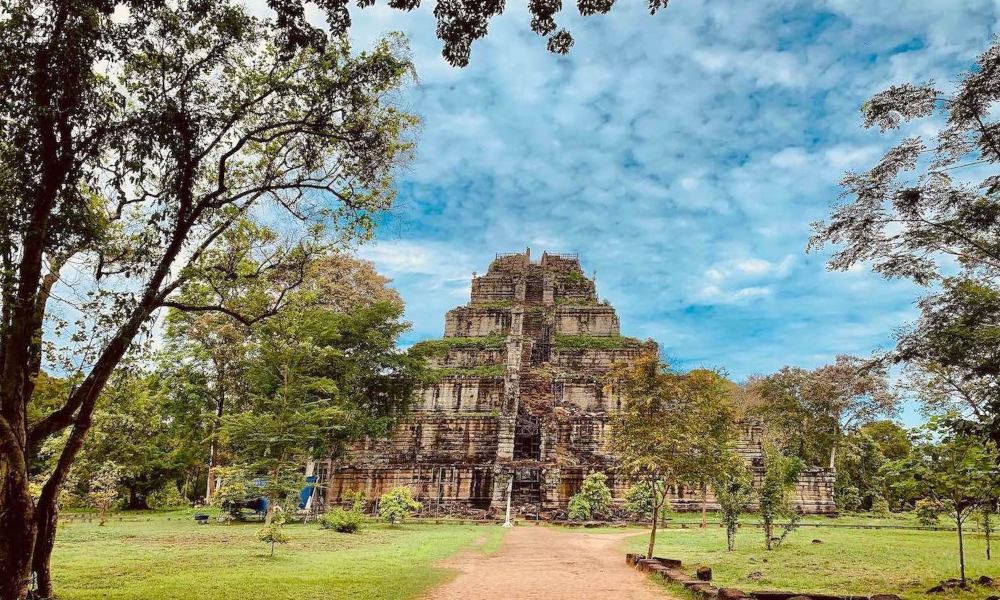Koh Ker Temple

Koh Ker served as the ancient capital of Cambodia, situated in Srayong Cheung village within the Srayong commune of the Kulen district, approximately 49 kilometers to the west of the provincial town. The Koh Ker complex is positioned on the Chhork Koki highland and was established by King Jayavaraman IV during the years AD 928 to 942. The Koh Ker temple, which stands at a height of 35 meters, is designed in the form of a seven-stepped stupa and is oriented westward towards the city of Angkor. It was constructed as a place of worship for Treypuvanesvara, the deity associated with happiness.
Table of Contents
ToggleTo date, a total of 96 temples have been identified within the Koh Ker area, including Dav, Rumlum Bey, Beung Veng, Trapiang Prey, Dey Chhnang, Srok Srolao, Lingam, Kuk Srakum, Trapiang Ta, And Many More. These temples are not clustered closely together, and many have succumbed to the ravages of time, with some now lying buried beneath the earth.
A brief one-day excursion allows for the exploration of the renowned remote sites, including Preah Vihear Temple, Koh Ker Temple, and Beng Mealea Temple, all...
Layout and Design
Koh Ker is located amidst the southern slopes of the Dangrek mountains, the Kulen mountains (Phnom Kulen) to the southwest, and the Tbeng mountain (Phnom Tbeng, near Tbeng Meanchey) to the east. The majority of the hilly terrain is enveloped in jungle, although many of the trees exhibit seasonal leaf shedding. Historically, the city of Koh Ker was situated along a crucial strategic route of the Khmer Empire. This route connected Angkor and Beng Mealea to Koh Ker, continuing on to Prasat Preah Vihear and further to Phimai in Thailand and Wat Phu in Laos. The Koh Ker region experiences a relatively dry climate. To secure a reliable water supply, numerous water tanks and canals were constructed during the 9th and 10th centuries. Currently, water is extracted from depths ranging from 30 to 40 meters (98 to 131 feet).
History of Koh Kor
Organize a private taxi to Koh Ker. The enjoyable 2.5-hour journey from Siem Reap traverses well-maintained roads, offering scenic views of cashew and banana plantations as well as rice fields. The route through Kulen Mountain can be conveniently paired with visits to both Koh Ker and Beng Mealea.
Upon entering the car park at Koh Ker, you will encounter restaurants, beverage kiosks, and a limited array of market stalls that offer fresh coconut drinks and souvenirs. Please note that there are no restroom facilities available in this area.
Should Visit or Not
Koh Ker is located within the dense jungle that lies between the Dangrek, Kulen, and Tbeng Mountains. Depending on the season of your visit, you may encounter the ruins either enveloped in lush greenery or starkly visible amidst the skeletal remains of trees. Spanning an area of 81 kilometers, Koh Ker is nearly comparable in size to the Angkor complex; however, its remote setting has resulted in significant destruction and looting over the years.
Regrettably, the rampant looting is a primary factor contributing to Koh Ker’s lack of popularity. Many of the most remarkable sculptures have been removed and are still being traded illegally. In 2011, Sotheby’s was embroiled in a controversy for auctioning one of the stolen sculptures from Koh Ker. Currently, the site features 42 structures in varying degrees of decay, primarily clustered around Prasat Thom, as well as along the winding paths that traverse the complex.
Koh Ker remains one of the least researched temple sites from the Angkor era. Much of the historical knowledge regarding the site was lost during the Khmer Rouge regime, rendering it largely enigmatic. Although it is in a state of disrepair, the site is only partially excavated, offering visitors a unique opportunity to discover something that has been long forgotten.
Location & How to Get There
Preah Palilay is situated approximately 400 meters to the north of Phimeanakas and 350 meters to the west of Tep Pranam within the historic city of Angkor Thom. Although it is somewhat removed from the main thoroughfare leading to the north gate, the journey through the forest to reach it is certainly worthwhile.
To access Preah Palilay, one may proceed northward along a narrow path originating from Phimeanakas. Alternatively, visitors can continue north toward the North Gate of Angkor Thom and then turn west after passing both the Terrace of the Elephants and the Terrace of the Leper King. The entrance to the path is located directly across from Preah Pithu, near several small shops and restaurants. This area serves as a popular parking location for tour buses and tuk-tuks, and it is also a favored spot for lunch breaks.

